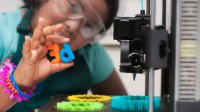How 3D Printing Can Boost Learning
This technology boosts engagement in high school, and teachers can use it to build a strong learning community.
Your content has been saved!
Go to My Saved Content.“Creation is an act of sheer will.” This quote from Jurassic Park could never be more true than in today’s age of technology. Computer-aided design (CAD) and 3D printing allow students to create like never before in the classroom. 3D printing is an emerging industry, and it shows potential with “printing” houses, cars, household items, and much more.
Educators can leverage this new technology to engage students with their state standards in innovative and exciting ways, as well as seamlessly integrating STEM into any classroom. I received a 3D printer in my classroom, and it’s something that my students and I have grown to love because it enhances lessons and helps build classroom community.
3D printing and classroom community
My Prusa MINI 3D printer strengthens the classroom community through rewards and building rapport with students. I walk into the classroom after class change and repeatedly see students staring at the 3D printer during its operation. In my social studies classroom, after each unit of study we play review games, including Kahoot, Quizizz, and Jeopardy. For the Kahoot winners, for example, I have 3D-printed Baby Yoda, the Ammit statue from Moon Knight, and various reptiles.
A fan favorite among students is almost anything with Dwayne Johnson’s face. On the website Thingiverse, people have placed Dwayne Johnson’s face on a squirrel, Tyrannosaurus rex (called T-Rocks), a hawk (Rock Hawk), and an octopus (Rocktopus), etc. As silly as this seems, students love it.
These 3D printed objects can also go to any student as a reward, not just Kahoot winners. Students showing improvement, going through a difficult time, contributing to a class discussion if they normally don’t, or arriving to class on time can all be reasons to present a student with a Dwayne Johnson face reward.
Interconnected to rewards, 3D printing can build rapport with students. Many students have gone on Thingiverse or created their own 3D objects for me to print. For example, a student found a 3D object of a skink, which happened to be one of her pets at home. She sent me the file and I printed it for her. When I handed her the skink, she was delighted about something very simple for me to do. Another student wanted a mallard printed, so he found the file and emailed it to me, and together we uploaded it to the 3D printer.
Many students enjoy anime, so we’ve been printing various anime objects. Anytime students and I can work together and have positive interactions, there’s an increased likelihood of their working harder in the classroom.
Using 3D printing to enhance lessons
Beyond fun, 3D printing has serious implications for enhancing lessons and improving the overall learning process for students. This includes both daily activities and larger project-based learning (PBL) units. As part of a unit on the Gilded Age in my U.S. history class, students used Tinkercad to design a Monopoly piece to use when they play the board game.
After students designed their 3D Monopoly piece, they exported the correct file type (.stl), added supports in a slicer program that created a g-code file, and then uploaded the g-code file to the 3D printer. Adding support helps ensure that the print job doesn’t fail. After printing, which sometimes can take eight to 10 hours, students were thrilled to have, in their hands, something they created.
3D printing can also serve as the foundation for PBLs. In my classroom, we’ve completed two PBLs that utilized 3D printing. The first one involved students designing a bridge that was as light as possible and could still hold the necessary amount of weight. Students designed and printed their bridge, and then tested it with a small concrete weight. Then students went back to Tinkercad and further tinkered with their bridge, trying to make it ever lighter.
The second PBL involved designing and printing an object to help either a person with disabilities or an elderly individual. Students had to create for an actual person they knew. For example, one student’s grandfather had arthritis in his fingers, so they designed a toothbrush holder that went around his wrist, allowing him to continue to brush his own teeth. Both of these PBLs invoked empathy and practical thinking from students while using 3D printing.
I’ve found that 3D printing greatly enhances the classroom experience, whether the objects are used as rewards or in lessons to get more buy-in from students. In my experience in high school social studies class, students really like it. If it’s the only thing they’re looking forward to that day, I consider that a win.
And this is just the beginning for 3D printing applications in high school classrooms. Math, science, and culinary arts could all use 3D printing to some capacity. For students, 3D printing can stimulate the imagination and make the act of creation more real than ever.
